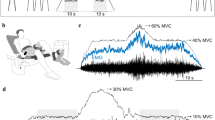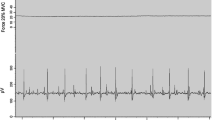Abstract
The modifications of motor unit recruitment strategy due to skill acquisition was determined in the elbow flexor-extensor muscles of normal human subjects. The median frequency of the power density spectra of the electromyograms recorded from the biceps and triceps muscles during a 3-s linear increase in flexion force in the range of 0–100% maximal voluntary contraction (MVC) was calculated for each subject, every 2 weeks over a total 6-week period during which subjects practiced linear flexion force increase three times a week. Electromyograms were recorded with two pairs of electrodes of different size and electrode spacing. It was shown that skill acquisition due to the 360 practice trials over the 6-week period caused an increase in the initial motor unit recruitment phase of the agonist's force generation cycle from about 0–65% MVC to about 0–85% MVC. The increase in the recruitment range was gradual and statistically significant for the measurements made every 2 weeks. The reccruitment range of the antagonist triceps demonstrated a minor, but statistically insignificant, decrease over the same training period. There was a minor, but statistically significant, advantage of using small electrodes and inter-electrode spacing. It was concluded that skill acquisition, due to repeated functional use of a muscle in the same contraction mode, results in a slower, prolonged recruitment of motor units in the initial segment of the force generation cycle, thereby allowing a more precise and accurate control of the increments of force increase. Such conclusions reinforce the concept advocating the plasticity of motor unit control according to the functional demands imposed on the muscle. The results have significant implications in the design of various athletic, occupational and rehabilitation training modalities for optimal performance of various movement functions.
Similar content being viewed by others
References
Arendt-Nielsen L, Forster A, Mills KR (1984) EMG power spectral shift and muscle fibre conduction velocity during human muscle fatigue. J Physiol (Lond) 353:54
Baratta R, Solomonow M, Zhou BH, Letson D, Chuinard R, D'Ambrosia R (1988) Muscular coactivation. The role of the antagonist musculature in maintaining knee stability. Am J Sports Med 16:113–122
Behm DG, Sale DG (1993) Velocity specificity of resistance training. Sports Med 15:374–388
Bernardi M, Solomonow M, Sanchez J, Baratta RV, Nguyen G (1995) Motor unit recruitment strategy of knee antagonist muscles in step-wise increasing isometric contraction. Eur J Appl Physiol 70:493–501
Bernardi M, Solomonow M, Baratta RV (1996) Motor unit recruitment strategy of antagonist muscle pair during linearly increasing contraction. Electromyogr Clin Neurophysiol (in press)
Bigland-Ritchie B, Donovan EF, Roussos CS (1981) Conduction velocity and EMG power spectrum changes in fatigue of sustained maximal efforts. J Appl Physiol 51:1300–1305
Bilodeau M, Arsenault AB, Gravel D, Bourbonnais D (1991) EMG power spectra of elbow extensors during ramp and step isometric contractions. Eur J Appl Physiol 63:24–28
Edstrom L, Grimby L (1986) Effect of exercise on the motor unit. Muscle Nerve 9:104–126
Fuglevand AJ, Winter DA, Patla AE, Shastuk D (1992) Detection of motor unit potentials with surface electrodes: influence of electrode size and spacing. Biol Cybern 67:143–153
Lindstrom LR, Magnusson R, Peterson I (1970) Muscular fatigue and action potential conduction velocity changes studied with frequency analysis of EMG signals. Electromyography 4:341–353
Moritani T (1993) Neuromuscular adaptations during the acquisition of muscle strength, power and motor tasks. J Biomech 26:95–107
Moritani T, Muro M (1987) Motor unit activity and surface electromyograph power spectrum during increasing force contraction. Eur J Appl Physiol 56:260–265
Person R (1958) Electromyographical study of coordination of the activity of human antagonist muscles in the process of developing motor habits. Jurn Vys'cei Nervn Dejat 8:17–27
Sanchez JH, Solomonow M, Baratta RV, D'Ambrosia R (1993) Control strategies of the elbow antagonist muscle pair during two types of increasing isometric contractions. J Electromyogr Kinesiol 3:33–40
Solomonow M (1984) External control of the neuromuscular system. IEEE Trans Biomed Eng 31:752–763
Solomonow M, Baratta RV, Zhou B-H, Shoji H, D'Ambrosia RD (1987) The EMG-force model of electrically stimulated muscle: dependence on contral strategy and predominant fibre composition. IEEE Trans Biomed Eng 34:692–703
Solomonow M, Baten C, Smit J, Baratta R, Hermens H, D'Ambrosia R, Shoji H (1990a) Electromyogram power spectra frequencies associated with motor unit recruitment strategies. J Appl Physiol 68:1177–1185
Solomonow M, Baratta RV, Shoji H, D'Ambrosia R (1990b) The EMG-force relationships of skeletal muscle; dependence on contraction rate, and motor units control strategy. Electromyogr Clin Neurophysiol 30:141–152
Solomonow M, Baratta RV, Zhou B-H, Bernardi M, Acierno S (1994) Surface and wire EMG crosstalk in neighboring muscles. J Electromyogr Kinesiol 4:131–142
Stulen FB, DeLuca CJ (1981) Frequency parameters of the myoelectric signal as a measure of muscle conduction velocity. IEEE Trans Biomed Eng 28:515–523
Winter D, Fugelvand A, Archer S (1994) Crosstalk in surface electromyography: theoretical and practical estimates. J Electromyogr Kinesiol 4:15–26
Zoutman AE (1989) Analysis of the surface EMG during voluntary contraction: the relations between the median frequency of the power density spectra and the contraction level. Thesis, Bioengineering Laboratory, Louisiana State University
Author information
Authors and Affiliations
Rights and permissions
About this article
Cite this article
Bernardi, M., Solomonow, M., Nguyen, G. et al. Motor unit recruitment strategy changes with skill acquisition. Europ. J. Appl. Physiol. 74, 52–59 (1996). https://doi.org/10.1007/BF00376494
Accepted:
Issue Date:
DOI: https://doi.org/10.1007/BF00376494




